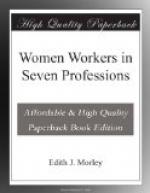As will be seen from the duties enumerated above, Women Inspectors, as a general rule, are brought into very close and intimate contact with the homes of the people, and this necessitates the exercise of much tact and patience. The large demands thus made upon their powers of persuasion and teaching capacity, involve a considerable strain upon their nervous energy as well as their physical strength. The work of the Men Inspectors, on the other hand, being of a more official character, does not involve the same strain.
There is no uniformity of practice with regard to hours of work, holidays, remuneration or superannuation, either within or without the metropolitan area. Each Local Authority makes its own arrangements. Many have no superannuation scheme and give no pensions. Men and women working for the same Authority usually work under the same conditions as to hours and holidays: the rate of remuneration, however, is by no means the same. The salaries of Women Sanitary Inspectors within the Metropolitan area range from L100 to L200 per annum, the latter figure being reached only in two boroughs and in the City of London: whilst the salaries of the men range from L150 to L350. The average maximum salary of the women is L150, and the average maximum salary of the men is L205. Outside London, the salaries of both men and women are lower, those of the women ranging from L65 to L100, a few rising to L150. Payments are made monthly, and a month’s notice can be demanded on leaving, though it is frequently not enforced. Another unjust distinction frequently made between men and women is that the latter are generally compelled to retire upon marriage, thus enforcing celibacy on some of our most capable women.
The hours of work are usually from 9 A.M. to 5 or 6 P.M. and to 1 P.M. on Saturdays. If we consider the nature of the work, the holidays appear most inadequate—viz.: only from two to three weeks per annum are allowed in London, and from ten to fourteen days in many provincial towns.
The Health Visitor, as a public official, was not known until 1899, when several were appointed by the City Council of Birmingham. The name “Health Visitor” was thought to be more feminine and suitable than that of Inspector, and it was imagined that she would in consequence be better received in the homes of the people. As a private society in Manchester had previously engaged women of an inferior class and education with the title of “Health Visitor,” this designation was deprecated by women already in the profession. Many smaller provincial towns, however, followed the example of Birmingham, and appointed Health Visitors instead of Women Sanitary Inspectors. It was not until later that the Health Visitor was introduced into London, and in the following way:—




